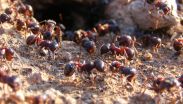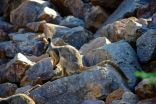(Press-News.org) A Case Western Reserve University graduate student turned a research paper into a field test that quickly determines whether an Asian carp invading Lake Erie is sterile or can reproduce.
If proven successful, the technique could save money and time in the effort to keep the carp out of the Great Lakes, where the fish could grow unchecked and devour food supplies and habitat critical to native species..
Grass carp, the species Ctenopharyngodon idella, have been introduced throughout the Midwest and South to clear ponds choked with weeds. Also called the white amur, fertile fish are illegal to release or buy and sell in Ohio and surrounding states, but have been found in Lake Erie's western basin.
Hatcheries have breeding carp, but shock their eggs with drastic changes in water pressure. The shock results in a third chromosome in the eggs and makes the fish that grow from them sterile. These sterile fish can then be responsibly used for biological control of invasive aquatic plants, but fertile fish could result in growing populations that could devastate the Great Lakes ecosystems.
The U.S. Fish & Wildlife Service and the Ohio Department of Natural Resources monitor for--and are trying to prevent--the spread of grass, black, silver and bighead carp into the Great Lakes.
To confirm whether grass carp caught in the Great Lakes can reproduce, conservation agents must have an eyeball or fresh blood taken from the species tested at a United States Geological Survey laboratory in Wisconsin. The test equipment can run to more than $80,000 a USGS field biologist said.
But Katherine Krynak, who recently earned a PhD in biology at Case Western Reserve, led the effort to develop an inexpensive test that can be done in a boat or on shore in about 15 minutes with a conventional microscope.
Krynak worked with Case Western Biology Instructor Ronald Oldfield and Cleveland Metroparks Zoo's Pam Dennis, a veterinary epidemiologist; Mike Durkalec, aquatic biologist; and Claire Weldon, aquatic research coordinator. Their research is published in the journal Biological Invasions.
"With this technique, people can quickly recognize the problem animals and remove them from the population," Krynak said.
While doing her homework for a research paper, she found that Chinese scientists had discovered the shape of the nuclei in red blood cells of hybridized goldfish and Wuchang bream--members of the carp family-- looked different depending upon whether the fish had a pair or three or more chromosomes. The proportion of abnormally shaped nuclei grew with the increasing number of chromosomes.
Krynak thought the cellular differences might be used to identify sterile grass carp from those that can reproduce, and therefore be used to monitor the species caught in the Great Lakes or rivers that feed them.
She discussed the ideas with Oldfield and they, Dennis, Durkalec and Weldon developed a technique they could use in the in the lab and field.
They smear a drop of fish blood on a slide, let it dry and fix it with methanol. They then stain the slide to bring out the nucleus, and, after rinsing and drying, view it under a standard microscope.
Like its relatives, sterile grass carp have a noticeably larger proportion of red blood cells with abnormal nuclei.
The researchers tested how well others could accurately differentiate sterile from normal fish. By viewing blood-smear slides, 14 of 15 staff and interns of the Natural Resources department of Cleveland Metroparks correctly identified the fish; a single intern incorrectly identified a single fish's reproductive potential.
Grass carp were first found in the Sandusky River, which flows into Lake Erie's western basin in 2012. Whether they came from fertile carp that were illegally or mistakenly brought into the area or originated from states such as Iowa, Missouri, Arkansas and Mississippi, which have permitted fertile fish since importation began in the 1960s, is unknown. But, the four caught had the potential to reproduce, and the minerals found in the bones of their heads, which can be used to track where the fish have been, indicated the fish had lived in the Sandusky all their lives.
Grass carp pose a number of threats because they eat soft-stem vegetation--the kinds of plants that dominate coastal marshes. The marshes are prime breeding grounds for game fish and act as filters that clear the water, said Eugene Braig, program director for the Aquatic Ecosystem Extension at Ohio State University.
Loss of the vegetation and native fish also poses a threat to ducks, geese and other large aquatic birds, the U.S. Geological Survey says.
"This test has the potential to be very helpful," Braig, said. "The results are pretty convincing, but I would like to see it field-tested by management agencies."
Braig said that if this method comes to be recognized as more affordable, consistent, and reproducible, it could become a new standard practice for agencies charged with protecting the Great Lakes.
INFORMATION:
Over time selective high schools have oriented themselves to address a context of increasingly competitive college admissions
School work, college applications, extracurricular activities, and parental expectations all contribute to teenagers' stress
Youth, schools, and experts identified substance use as a common strategy for coping with stress
"School, homework, extracurricular activities, sleep, repeat--that's what it can be for some of these students," says Noelle Leonard, PhD, a senior research scientist at the New York University College of Nursing (NYUCN). ...
If the thought of a post workout ice bath is enough to make you shiver, new research from QUT and The University of Queensland (UQ) will warm your heart.
The comprehensive study found cold water immersion after strength training hindered muscle adaptation - pouring cold water on the long-held theory that an ice bath helps speed up recovery.
Dr Llion Roberts, from UQ's School of Human Movement and Nutrition Sciences, and Dr Jonathan Peake, from QUT's School of Biomedical Sciences, led the research, with colleagues from the Queensland Academy of Sport, Norwegian School ...
Drugs called ion channel blockers, which are commonly used to treat cardiac, neurological, and psychiatric disorders, might prove useful in cancer therapy, according to research findings in fruit flies and mice by UC San Francisco scientists that led to unconventional treatment of a case of metastatic brain cancer.
Ion channels, proteins that form pores in cell membranes, play central roles in organs in which conduction of electrical signals is vital, such as the brain and heart, but they are found in cells throughout the body. Although about 20 percent of FDA-approved ...
Sydney, Australia -- Reintroducing Tasmanian devils to the mainland could improve biodiversity by limiting the spread of red foxes and feral cats in habitats where dingoes have been culled, a new study suggests.
Tasmanian devils (Sarcophilus harrisii) once lived across the Australian continent, but went extinct on the mainland about 3,000 years ago - likely as a consequence of being hunted by dingoes.
Today, extensive dingo culls to protect livestock have shifted the ecological balance, paving the way for invasive predators to wreak havoc with native mammals, worsening ...
SEATTLE, WA, AUGUST 11, 2015 - A statistical model--now an easy-to-use software tool--local police can use to identify a series of related crimes and nab a suspect was unveiled today by Michael D. Porter during a presentation at the 2015 Joint Statistical Meetings (JSM 2015) in Seattle.
Porter presented a talk titled "A Statistical Approach to Crime Linkage during a session focused on improving analysis of defense systems using statistical methods. He collaborated on the project with Brian J. Reich, associate professor of statistics at North Carolina State University.
Crime ...
An international team of researchers found that the evolutionary loss of the "altruistic" worker caste in ants is not accompanied by a loss of genes.
Social insects, such as ants, are typically characterized by two distinct female castes: workers and queens. Previous research has found that workers and queens each express different sets of genes leading scientists to speculate that there are worker specific or "altruistic" genes that promote sociality.
Testing this "novel gene" hypothesis is difficult given that all ants are social. However, not all ants make workers. ...
Controlling feral pigs is the most cost-effective strategy to help save 148 endangered plant and animal species in the Lake Eyre Basin, and is just one of the significant findings of a three-year study led by QUT applied ecologist Associate Professor Jennifer Firn.
Professor Firn, from QUT's Institute for Future Environments, worked with Dr Josie Carwardine and CSIRO's Conservation Decisions team and a research team from the University of Queensland including Dr Ramona Maggini, to identify and prioritise 23 strategies to protect endemic species in the world's largest ...
Until now only known for role in polyglutamine diseases, such as Huntington's.
Scientists at VIB and KU Leuven have revealed that variable polyglutamine repeats in the DNA tune the function of the protein in which they reside. To date, these repeats were known only to cause severe neurodegenerative diseases such as Huntington's. These findings now show that polyglutamine repeats may be more than just harmful elements. The study was published in the leading molecular biology journal Molecular Cell and opens the door to further studies exploring new therapies for human ...
Widespread species are at just as high risk of being wiped out as rare ones after global mass extinction events, says new research by UK scientists.
There have been five mass extinction events in the Earth's history, including climate change caused by volcanoes and an asteroid hit that wiped out the dinosaurs.
In general, geographically widespread animals are less likely to become extinct than animals with smaller geographic ranges, offering insurance against regional environmental catastrophes.
However, a study published in Nature Communications has found this insurance ...
A natural compound called limonene, which is found in oranges and lemons, could be indicative in early-stage diagnosis of liver disease, according to research published in the journal EBioMedicine by researchers in the Molecular Physics Group at the University of Birmingham.
Limonene occurs in the greatest abundance in citrus fruits, but it is also found in a large variety of other fruit and vegetables. It can be ingested or inhaled as it is a common additive in commercial food and drinks, is used to give the fruit flavour to some sweets and is used in cosmetics, ...

